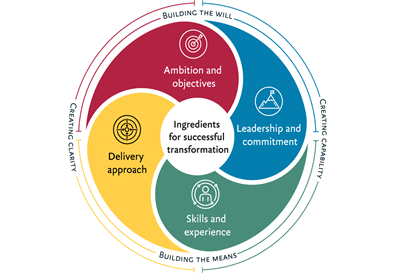Do your development initiatives keep getting approved but then shelved? What's going wrong?
Discussing and debating your options with your colleagues and presenting a unified, compelling strategy to the board is a great first step. But unfortunately that’s all it is. A first step. So what can you do to get your program moving?
1. Devise a meaningful change program
First, rally your delivery team behind a realistic implementation plan. The best way to get buy-in is to involve your delivery leads throughout the planning process.
To give your plan focus, think about key triggers or events that will affect your timetable. If those are more than a year away, try to identify some interim milestones in the next six months. Any longer than six months and you'll encounter unknowns or unforeseen events that will reduce the value of your plan.
Break the plan into workstreams that can be owned by delivery leads, but also ensure that someone is appointed to keep the program together. They need to look out for dependencies between streams and keep their eye on the bigger picture.
Make sure your plan sits within the overall change effort across the business so that you're aware of any other demands on your key stakeholders and critical resources.
Your delivery team needs to own the plan and be able to sell it into the key stakeholders.
Ensure that there is a simple, balanced way of tracking progress against the plan so that you can sense how well you're progressing through the journey and where intervention is required.
2. Organize the delivery team
The organization of the delivery team needs to be carefully considered. You might want to draw on selected expertise from across the business to promote cross-functional ownership but bear in mind that that might cause a distraction from day-to-day business demands and confusion with existing reporting lines. Would it be better to establish a dedicated team, asking certain people to focus exclusively on this project? If so, think about how business-as-usual would suffer and how those people would transition both out and back into their usual responsibilities.
Your answer will lie in the urgency, complexity and capabilities required to deliver your change program.
Review your team structures throughout the change program and flex the optimal team structure accordingly.
3. Unlock team aspirations
Wherever possible, assign tasks to people that reflect their ambitions. If your delivery team can see a way of furthering their own career and personal development aspirations through the change effort, they will be all the more motivated to achieve the change. This goes for vendors too.
Build relationships that allow for mutual benefit to be derived from successful delivery.
You should ensure that your governance procedures keep the team tied to the business agenda, clearly linking team effort to the goals of the overall business. If changes do occur, make sure you explain the rationale and context so that your delivery team is in tune with the need to change.
You need to ensure that your delivery team has the opportunity to succeed. So make sure they have the time and resources required and show your ongoing commitment and enthusiasm for their effort every day.
4. Demonstrate executive commitment
The implementation effort needs to be driven from the highest levels of the organization. The executive team has to show complete and public commitment to the program and focus the management of the organization accordingly.
Above all, don't rush it
Mobilizing a program effectively takes time.
There are many angles to consider, many alternatives available. Resist the temptation to dive into the work as your timeframes are tight and you want to promote a sense of urgency.
Give your team time to come up to the level of understanding that you have, and let them feel involvement and ownership for delivery. Time invested in effective program set-up will prove to be time well spent.











